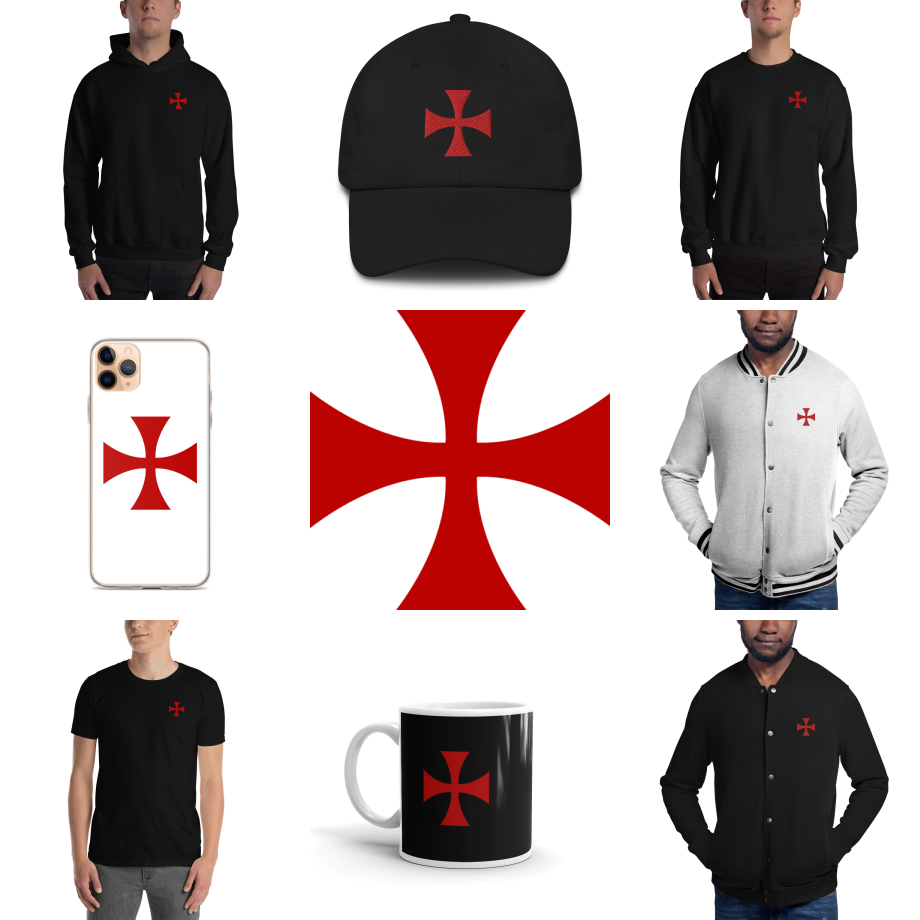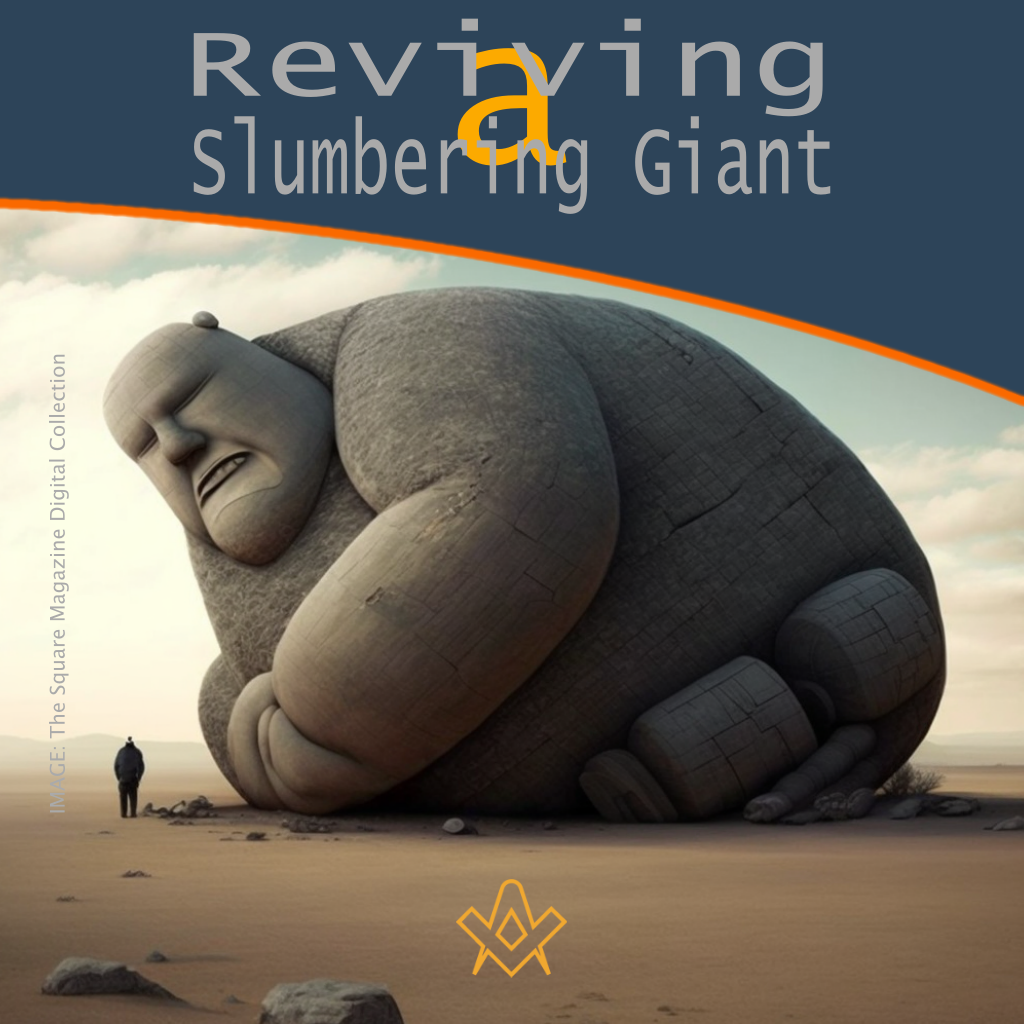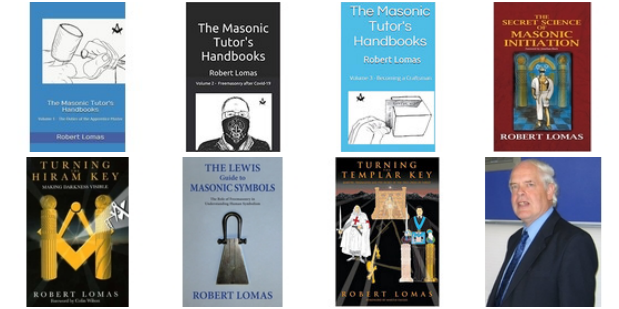Lockdowns, dwindling memberships, and now a cost-of-living crisis. What can we do to help our lodges recover from the most serious threat to our survival that we have faced since our very beginnings?
We say that Freemasonry is a progressive science, but what does that mean if we view it through the prism of the recent pandemic?
And what implications does progression have for the recovery of the Craft?
Reviving a Slumbering Giant
In the northern hemisphere, during the northern winter solstice, darkness reaches its peak power. The light seems to have been almost defeated, as the sun hides further below the southern horizon.
The sunrise keeps moving further and further into the southeast. The mornings are dark, the days are dull and the evenings darker. Then, just as we feel that night is going to engulf us for ever, something magical happens.
The sun stops moving south, pauses for a while to consider its options and then starts to move back towards the north. The days lengthen, the evenings lighten and a hope of spring lifts our hearts.
This turning point of the year has a strong symbolic influence on our spirits. It’s when we bring lights and evergreen plants into our homes to remind us that the light will return. Many great religions hold festivals of light at this time of year, Hanukkah, Christmas, Diwali.
And many Masonic lodges hold their installation ceremonies when the lodge is symbolically reborn to face the coming year afresh.
The return of light is a beacon of hope for the future, but the shortest day of the year is also a time for reflection.
In 2020-2021, we took part in a dangerous and compulsory experiment. We placed our Craft in an artificially induced coma, keeping its life breath of meetings flowing via the artificial ventilator of video get-togethers. Then, with the successful rollout of vaccines, we faced the risky business of arousing this slumbering giant.
I would like to suggest that now is the time to take a few moments to consider how successful our attempts to restart Freemasonry have been over the last year and what are the long-term prospects.
Some twelve months ago, we started to return to physical lodge meetings. Then we were still living under the threat of further lockdowns, whilst still trying to break free from two years of mothballing.
We were worrying that with a new strain of Covid appearing there was a real danger our meetings would once again become a forbidden pleasure. We still carried face masks in our regalia cases because we weren’t sure if we might be forced to wear them.

Zoomed Out
image credit: the square magazine digital collection
Not everyone was ready to return to face-to-face meetings. Many brethren had forsaken the habit of going out. ‘Working From Home’ was morphing into ‘Attending Lodge from Home’.
But video meetings are a poor substitute for real meetings, as we soon discovered when we cautiously crept back into our neglected Masonic halls.
Certainly, things are looking much better than they were twelve months ago. Now we have once more got used to meeting, shaking hands, Initiating, Passing and Raising Candidates and even holding festive boards.
I have even seen a welcome return of the joy of sharing an Apprentice’s Chain. And nothing dreadful has happened yet.
However, we are facing new challenges as the cost of heating and lighting our halls becomes a serious threat to capitation fees.
The rising cost of catering also makes our feasts more expensive. Freemasonry is in danger of drifting and morphing into an expensive disposable luxury when everyone is feeling the impact of the cost-of-living crisis.
During the Pandemic we lost many senior brethren, our ranks of skilled ritualists were sadly depleted, and organists seem to have been moved onto the red list of endangered species.
Many lodges who struggled through lockdown now struggle to officer their lodges, and quite a few are handing back their warrants.
Some try amalgamating with other struggling lodges, perhaps to form a larger quarrelsome lodge that still struggles.
What can we do to help our lodges recover from the most serious threat to our survival that we have faced since our very beginnings?
We say that Freemasonry is a progressive science, but what does that mean if we view it through the prism of the recent pandemic? And what implications does progression have for the recovery of the Craft?
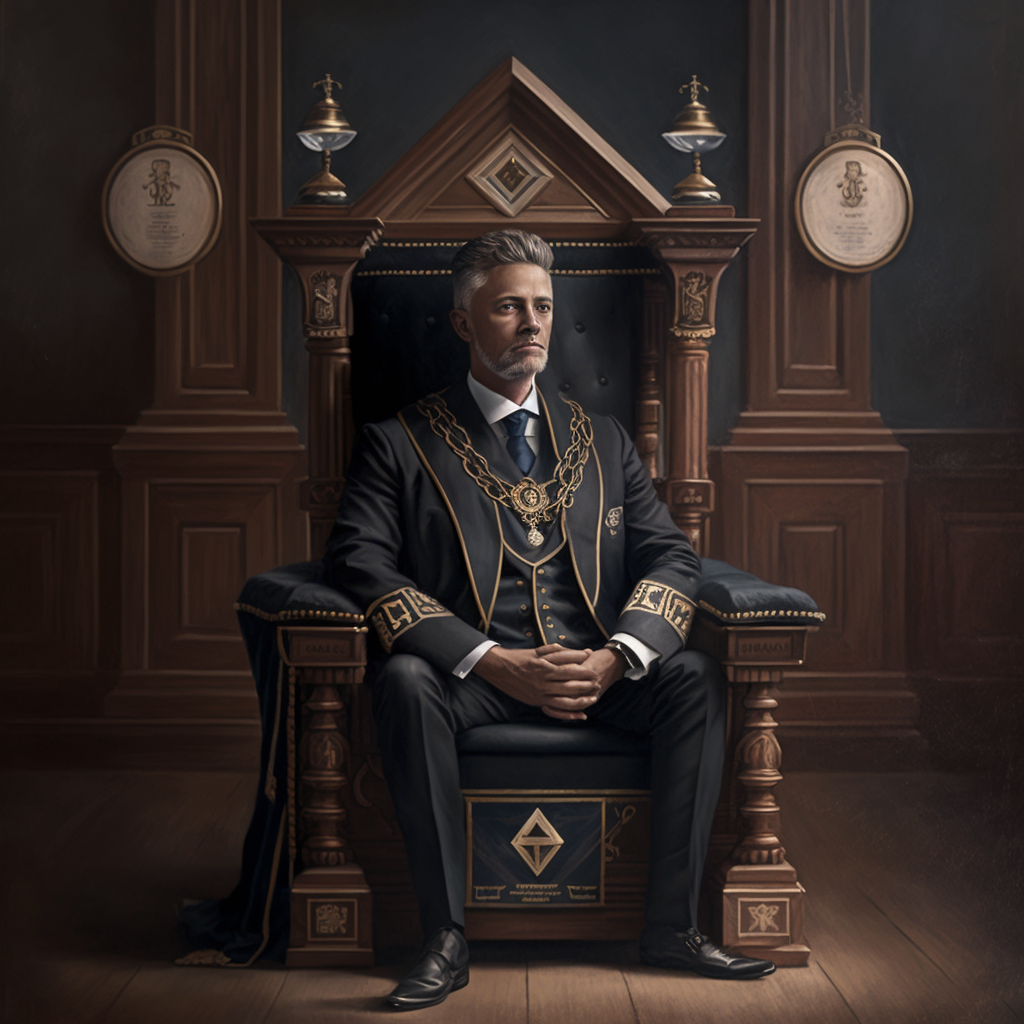
recycled past masters
image credit: the square magazine digital collection
The progressive nature of Freemasonry begins by Candidates having Freemasonry done to them. They Enter as Apprentices, Pass as Fellowcrafts and are Raised to the Sublime Degree of a Master Mason, but only then do they start to progress through the offices that educate them in what Freemasonry can do for them, and how they can share these benefits with others.
Without the knowledge gained by working each office, our Order will quickly become unable to pass on its wisdom or inspire the loyalty of its Past Masters.
The new Master Mason starts as a Steward, moves to Inner Guard, then Junior and Senior Deacon, before progressing to Junior, then Senior Warden. Whilst working each office a Mason learns more about our antient Craft, until seven years after their Raising they are properly prepared to take the chair of the lodge.
Armed with their Master’s trowel, plumb line, and plan, they learn how to use the cement of Brotherly Love to bind the lodge into an upright corporate whole, built on a plan which reflects the purpose of life.
Then they move away from the active offices that impart Freemasonry to others, to take on the reflective and supportive office of Immediate Past Master. Whilst seated at the Worshipful Master’s left hand, they can consider and internalise the meaning of the workings they have now fully experienced.
The progression of offices is where the wisdom of the Craft is transferred to the next generation, and it is not a process which can be rushed or short circuited. This method of progression implies that every lodge needs to initiate at least one new Candidate every year, and ideally a least one new Master Mason a year should receive their Grand Lodge Certificate.
Each of the progressive offices lasts for a year, and to benefit fully from their insights they must be taken in the proper sequence. Missing out on an office, or being forced to jump up the ladder, leaves serious gaps in the understanding of the individuals and can often result in disenchantment.
Lodges can recycle Past Masters into vacant offices, but too many recycled incumbents occupying the progressive offices, is a sign that a lodge is struggling to survive.
Past Masters can be usefully employed as Chaplains, Secretaries, Organists, Almoners, Treasurers, Mentors, and Membership officers, but the progressive offices ought to be occupied by brethren wearing light-blue, rosette-decorated, aprons.
And the successful completion of a year’s work in each progressive office should be a prerequisite for taking the next step up the ladder.
Progression, for a successful lodge, means planning your lodge membership to initiate at least one new candidate every year, and to award at least one grand lodge certificate every year.
Effectively, this steady progression has been rudely interrupted for three years, and this is showing in the number of lodges who are struggling to revive and survive.
Even if a lodge was doing well before lockdown, it may now be struggling as it had not progressed any potential new Masters for nearly three years. This implies that even a previously successful lodge will take at least three years to rebuild a proper progression.
Subsequently, if we do not initiate enough Candidates who then progress to the degree of Master Mason, this will get worse. Simply pushing lots more Candidates through will not solve the issue either.
If the progression is to work as it was intended, then the lodge can only bring one new officer into the ladder each year. If a lodge initiates too many Candidates, then either it has lots of Master Masons stuck as Stewards, whilst recycling Past Masters in active offices, or is forcing individuals to miss out by skipping offices.
Both these options are unsatisfactory for the long-term welfare of the individuals and the lodge.
It is a tricky balance to achieve. Too many Candidates result in a poor progression experience, whilst too few Candidates result in a stagnant dark blue ladder.
One way of managing a steady, refreshing, flow of keen candidates is to make sure that individuals are not rushed through the basic degrees too quickly, and everyone is given all the normal teachings of the degree;
[i.e., make sure they get an explanation of the degree, the ritual of the tracing board, and all the catechismal lectures, along with an opportunity to see the degree conferred on someone else, before thinking of moving the individual to the next degree. And do this over a period of weeks, allowing time for discussion and reflection on the material in the lectures before rushing into the next degree.]
Pushing new brethren on too quickly only results in disenchantment and possibly resignation. Under such progressive restraints, even a previously successful lodge will take at least three years to stabilise its ladder, and lodges which were struggling before lockdown will take longer.
Unfortunately, there is no short cut, our lodges are suffering the consequences of Long Covid, and to restore them to full health will take time, effort, and a firm understanding of the nature of the damage that three years of hibernation has inflicted on our Order.
The main factors which Lockdown has exacerbated are:
1: Loss of support from the Baby Boomer Generation:
Boomers started their adult lives determined to change the world, and strongly contributed to the rise in the number and strength of membership figures from the 1970s onwards.
They started retiring in 2011. They were the last generation which joined Freemasonry, expecting them to work to assist the Craft to achieve its goals.
But during lockdown they discovered how to avoid having to turn up and be counted. By 2029, what Baby Boomers we have left will be retired.
By 2034, the last of the Boomer generation will be seventy and many will be preparing to Ascend to the Grand Lodge Above.
The Craft will have far fewer Boomers as members. Yet this generation are the ones, who since the lodges reopened, are having work to rebuild what they previously thought was a job already done.
Not all want to start all over again. The natural loss of the Baby Boomers portents a massive change for lodges because they will not be able to rely on these active, engaged, and supportive members to support their revival, let alone, growth.
If our lodges are to thrive into the future, they must be attractive to all generations. Our organisational culture needs to nurture the interests and concerns of a generationally diverse community.
Creating an organisation that appeals to younger generations means instilling an innovative, proactive, and member-responsive culture throughout our Craft structure.
We need to consider what later generations are looking for in Freemasonry, if indeed we can get them to take any interest.
2: The Rise of Generations X, Y, and the Millennials:
Generation X grew up during times of high divorce rates when it was very likely that both parents were working.
They tend to be highly independent, and protective of their work-life balance. Generation Y grew up with the internet and a constant barrage of messages from a variety of media.
They are highly educated, innovative, entrepreneurial, cause-driven, marketing savvy and globally focussed. They tend to be aspirational and attracted to successful brands.
They have different expectations to Baby Boomers when it comes to lodge membership. To justify the investment of time and/or money into a lodge they want to see clearly defined, tangible and compelling value – and not just when they join but if they are to progress.
Younger members are constantly reassessing the value of the organisation to them, so the Craft’s value needs to be regularly reinforced even after they have been persuaded to join, if we want to retain them.
Younger members are less willing to be a part of an association that demands, rather the requests nicely.
They would rather be part of a responsive, innovative, socially aware organisation that they perceive be successful. If they don’t see that in Freemasonry, they will not stay.
For our Craft to thrive, we need to understand what value it can deliver to younger members and be willing to provide that value.
We must also think about how we communicate that value to both prospective, and existing members, to motivate them to join, and engage, with us.
We must be able to explain, and promote the value, of the benefits of being a Freemason to sceptical young people.
When I was initiated into Ryburn Lodge No 1283 in 1987, there were over 8,000 active lodges in England and Wales, and over 330,000 active Masons.
Freemasonry was seen as a secretive but useful Order, which had been growing steadily since the end of World War I.
In the first four years of my Masonic life, about 200 new lodges were created and after accounting for the losses to the Grand Lodge Above, about 20,000 new Masons were added to our ranks each year.
Yet just five years’ later UGLE was looking back at what, we now see, was Peak Freemasonry.
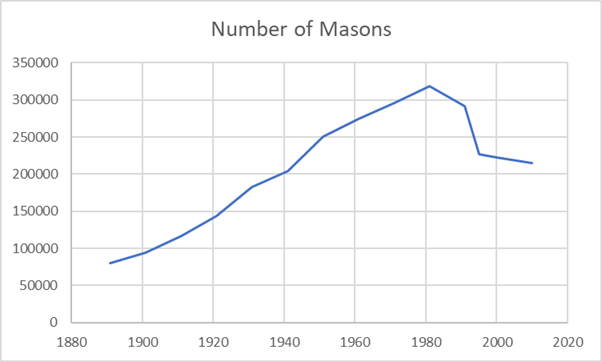
UGLE Memberships
UGLE Membership was steadily increasing up the end of the 1980s, after which there was an abrupt decline during the 1990s. The rate of decline slowed down during the 2000s and was beginning to revive a little when lockdown hit us.
In 2021, I published a statistical tool for measuring the success of recruitment and retention, which I called the F-Number. [The Masonic Tutor’s Handbooks – Volume 2, Freemasonry – The New Reality, 2021, p15]
To sustain its traditional progressive ritual teaching system, Freemasonry requires a continuous supply of Candidates to progress through the offices to the chair. If a lodge is recycling Past Masters, it does not have enough Candidates to remain healthy.
Any lodge which does not initiate at least one Candidate every year cannot maintain a continuous ladder from Inner Guard to IPM.
This process suggested a simple measure to show if Freemasonry is expanding, declining or static. Divide the number of GL certificates issued each year by the number of active lodges, and you have a measure of growth.
It’s a sort of R number for the infectivity of Freemasonry, and unlike Covid-19, the Craft needs its R number to stay above 1. I called this measure the ‘F number’ (F for Freemasonry).
If you think of it working rather like the Covid R number, then you will understand it. If F is above 1 then Freemasonry spreads, if it falls below 1 then it dies away.
When I look back to the good times of 1982, when UGLE issued 15,700 certificates to 8,207 lodges, this represented an F number of 1.91: plenty of scope for expansion.
By 1997, UGLE issued 10,200 certificates to 8047 lodges: still an F number of 1.25 but showing that growth had slowed by 35%.
During the twentieth century, Freemasonry grew to a size that dwarfed anything it had achieved in the two previous centuries. This means that the current membership only knows how to manage growth.
They have no experience of recovering from an externally enforced drop in membership such as resulted from Lockdown.
This failure to respond shows clearly in the pattern of the F number over the years. I have plotted the F Number for UGLE lodges since the start of WWI in 1914 down to the start of Lockdown (below).
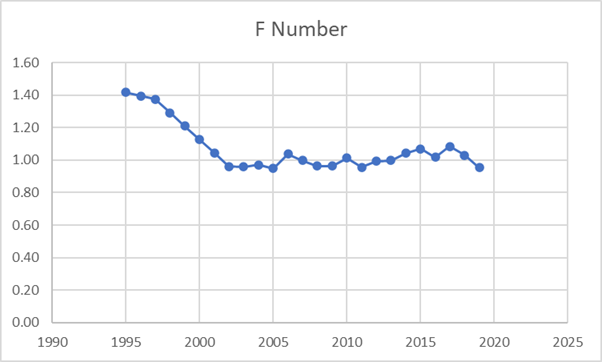
In 1920, UGLE issued 31,000 MM certificates. This meant that on average there were eight new successful Candidates for every lodge. It took years to reach the chair.
This pressure for preferment, was addressed by a rapid growth in new lodges and additional halls which laid the foundations for our present issues of expensive resources with too few members to fund them.
In the diagram below, I have plotted the F Number from 2012 to 2021. In 2019, UGLE issued 6,453 MM certificates for 6,769 lodges, giving an F number of 0.95, showing that even before lockdown we were not recruiting enough Candidates to provide one for every lodge. Since UGLE released the figures down to 2021 I have refined the recent years of the chart.
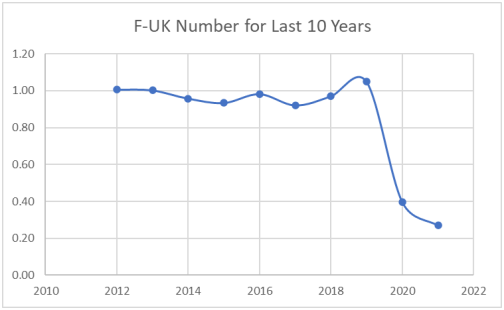
Here are the raw numbers.
Year F UK
2012 1.01
2013 1.00
2014 0.96
2015 0.93
2016 0.98
2017 0.92
2018 0.97
2019 1.05
2020 0.40
2021 0.27
At the end of 2020, we had 6427 surviving lodges and UGLE issued 2553 MM Certificates. This gave us an F number of 0.39. This implies that 61% of the surviving lodge were unable to meet the normal criteria for progression of the offices for their members.
But end of 2021 we had 64 fewer lodges, leaving 6363 surviving, and UGLE issued just 1,717 Master Mason Certificates. This gives an F Number of 0.27 showing the proportion of lodges at risk has increased to 73%.
In the last ten years, the number of active lodges has reduced by 616. [This is the net difference between old lodges closing and new ones being formed.]
If we want our Order with its lodges and Masonic halls to revive and survive, we need to encourage new Candidates and nurture those we already have.
The simple calculations, shown above, assume that we are not losing members by resignations and deaths. I am sure we must be, but UGLE does not publish the figures, so it isn’t possible to make a more realistic assessment.
The figures we do have, however, paint an alarming picture of continuing decline.
To remedy this position, we need to think about what we offer potential recruits. If we try to pitch ourselves as a charity, or a networking social organisation, then we are competing against more efficient providers offering better value.
If you want to undertake charity it is more logical to join the RNLI or Oxfam, rather than pay lodge fees to a less efficient charitable provider, and you don’t have to buy regalia from the RNLI or Oxfam.
We undertake charity as a by-product of our raison d’être, not as our main objective. If you want to network professionally then join LinkedIn, or if you went to university as many young people have, then join your alumni society.
They both do a better job with a wider possible group of contacts than your local lodge can offer.
But our Craft does have one unique selling proposition. We are the oldest philosophical self-help society in the western world.
We have a well-honed ritual development system which offers three benefits:
the comradeship of Brotherly Love,
the charitable support of Relief, and
the study of Truth.
We are the only fraternal organisation that offers to teach Candidates about themselves, about the world they live in, and how to approach the great questions of ‘Why are we here?’ and ‘What are we here for?’
As a side effect, we also inculcate self-confidence, public speaking, memory techniques, meeting administration, and a whole raft of transferable social skills, within a framework where you meet a wide range of interesting local people.
Our system of progressive offices is a tried and tested way of developing a personal understanding of your own Truth.
Our three great principles have sustained us for hundreds of years, and we now need to re-establish this system for the modern age before too many lodges die.
I have been systematically documenting my own practical suggestions about how to recruit, and retain, individuals in my Masonic Tutor’s Handbook series.
I would like to close this article with the positive news that I have seen quite a few lodges beginning to rebuild successfully.
They have realised that if they want to recruit and retain new members, they need to make sure that their new brethren are taught both to understand the nature of our secrets, and that we make the best use of our tried and test method of progression to pass them on.
Successful lodges use a mix of personal tuition, combined with online distribution of material, which is personally supplied, and discussed with, a trusted Masonic Tutor.
This is working well with the lodges I am supporting, and I am concentrating on making sure the lodges I like to attend are helped to survive.
In my view, the key element to Masonic revival is creating a personal relationship between a committed Masonic tutor, ideally the proposer or seconder, and a candidate.
The ritual forms of words are learned online, but the floorwork is taught in a physical practice lodge. When this is combined with supplying the background material needed to teach and encourage the study of Truth, underpinned with an undertaking to provide answers to any questions the Candidate might ask, the lodge thrives.
These lodges do not tell Candidates what to think, they encourage them to think and invite them to discuss their thoughts in a friendly and supportive community of like-minded individuals.
They also provide traditional ritual teaching in an appropriate, timely, and effective manner.
Understanding the issues of recruitment and retention is a necessary first step to recovery, and I look forward to 2023 with the hope that more lodges will take on this responsibility, and help our Order revive.
Article by: Robert Lomas

Robert Lomas has a BSc (First Class Honours) in Electronics and a PhD in the Quantum Physics of Solid State Devices.
He became a Freemason in 1987. Robert has a long-time interest in Masonic Education and for the last 24 years has been a regular lecturer on Masonic topics at lodges throughout the UK as well as abroad.
He co-authored the international best seller 'The Hiram Key'. Robert’s writings have been translated into 54 different languages.
Recent Articles: by Robert Lomas
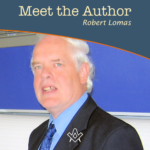
Meet The Author
Editor Philippa Lee interviews well-known Masonic author Dr Robert Lomas
more....

Book Review - The Masonic Tutor's Handbook 2
A review of The Masonic Tutor's Handbooks: Vol 2 - Freemasonry - After Covid 19 by Robert Lomas
more....
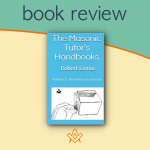
Book Review - The Masonic Tutor's Handbook 3
Becoming a Craftsman -The Masonic Tutor's Handbooks: Volume 3 - The relationship between a Fellowcraft and their Master is how the traditional wisdom of our Craft is passed on.
more....

Elias Ashmole: Masonic Hero or Scheming Chancer?
The debate is on! Two eminent Masonic scholars go head to head: Yasha Beresiner proposes that Elias Ashmole was 'a Masonic hero', whereas Robert Lomas posits that Ashmole was a 'scheming chancer'.
more....
Recent Articles: membership
 A Rose by any other Name may not be the same Explore the profound distinctions between conferred and transmitted Masonic degrees with Bro. Scott Wisdahl. Delve into how presentation quality, personal impact, and setting shape these rituals, and consider the potential for digital adaptations in modern Masonic practices. Join the discussion on enhancing the Masonic journey and preserving its essence. |
 Progression through the Degrees; a Rite or a Privilege? Exploring the layered journey of Freemasonry, Matt DA Fletcher probes the essence of progression—whether it's a mere rite or a privileged path. Delve into a nuanced perspective where every degree is not just a milestone but a fraction of a grander continuum. |
 Quantity vs Quality within the world of Freemasonry Dive into the compelling debate of quantity vs quality within the world of Freemasonry. Discover the transformative focus on attracting members aligned with the institution's values, promising not only growth but quality growth. High-value individuals assure sustainable development with their commitment to serving the brotherhood. |
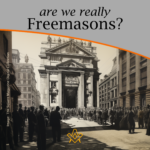 Maybe Freemasonry has opened its doors too wide. Perhaps some have not understood that the survival of Freemasonry in order to achieve its sublime purpose lies not in the number of members it has, but in their quality. Maybe we need less members and more Freemasons. Less men in Freemasonry and more Freemasonry in men. |
 What is ritual and why is it important? P1 Delve into the profound world of Freemasonry rituals and their significance. This insightful piece unravels the underlying importance of rituals, their impact on participants, and the transformative power they hold. Uncover why these centuries-old traditions remain integral to Masonic practice today. |
 Could Freemasonry be helpful for young men? Unravel the Masonic Brotherhood: Could Freemasonry be the antidote to modernity's challenges for young men? Dive in as we explore the Masonic world, its principles, camaraderie, and how its traditional rituals could help forge stronger identities in an increasingly complex world. |
 Discover the remarkable benefits of Lodge Meetings on your well-being. From fostering connections to combating stress, learn how these male-oriented gatherings offer an antidote to anger, hunger, isolation, and exhaustion. Dive into the power of shared experiences, understanding, and camaraderie. Your key to improved mental health awaits inside. |
 Tutorial for a Worshipful Master Unlock the Secrets to Leadership Mastery in our Worshipful Master's Tutorial! Brother Antonio Biella shares step-by-step guidance for Masonic Lodge leaders on honing their roles, duties, and future vision. Discover how to drive growth and engagement in your Lodge, setting ambitious goals and inspiring member participation. |
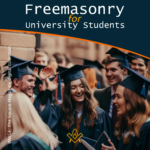 Freemasonry for University Students What are social skillset challenges facing students when they graduate from university ? |
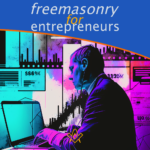 How the Core Values of Freemasonry; Brotherly Love, Relief and Truth Can Be Applied to Improve Productivity For Entrepreneurs |
 Why I became a Freemason: a personal journey of self-improvement Salik Tariq shares his reasons for becoming a Freemason – a journey of self-improvement, finding a community, and personal growth. |
 Freemasonry: Coming out of the Cloisters This paper examines the fundamental tensions on the lines of religion, gender and political ideology that exist in some jurisdictions of Freemasonry. It is on the first of these, religion, on which he makes an initial and exploratory focus. - by Gerald Reilly |
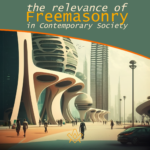 The Relevance of Freemasonry in Contemporary Society The role of Freemasonry in contemporary society is an indispensable one. Despite the challenges and misconceptions it faces, the organization remains steadfast in its humanitarian pursuits and commitment to personal growth and self-betterment. Through its efforts to evolve and adapt to the changing needs of its members and the world, Freemasonry continues to be a vital force in shaping a better future for all. |
 Has Freemasonry managed to revive and thrive after the darkness of the Pandemic? Robert Lomas gives us some (promising) insights. |
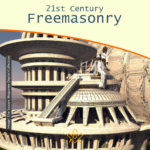 21st Century Freemasonry – a Sign of the Times? A recent article in The Times of London highlighted the dilemma 21st Freemasonry is facing. In this article one Master Mason shares his views of the strengths, and the challenges of modern Masonry. |
 A concept that is both based on our Freemasonic rituals and what we understand as teamwork. This article by Chris Batty examines why teamwork in the lodge is the network that binds us. |
 Lebanese Freemasonry has been both witness to and sometimes participants in turbulent events and forces, which shaped and influenced their world. |
 Is a Masonic Tradition Necessary? Dealing with Masonic tradition is a complex subject that requires careful analysis in order to reach a balanced point on the best etymological definition and the set of discourses and practices, which often end up being presented as such, without, however, presenting bases that support them, often serving only as a discourse that restricts and controls the masses. Fernando Rodrigues de Souza debates this complex subject. |
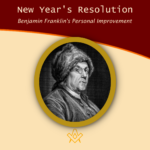 New Year's Resolution with Benjamin Franklin's Personal Improvement Are you ready for a new year's resolution challenge ? To accomplish his life’s goals, at 25 ( around 290 years ago ), Benjamin Franklin developed and committed himself to a personal improvement program that consisted of 13 virtues. You are invited to join me in practicing his daily routine for 2023. |
 The Alberta Masonic Higher Education Bursary Fund is to help the next generation of Albertans, our children and grandchildren, to obtain the education they need to lead successful lives and contribute to the welfare of mankind. As you can see from this little lesson of our history, education is truly a Masonic obligation. |
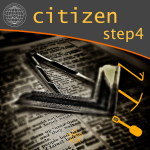 To be a Better Citizen of the World: Step 4 A value proposition for Pure Ancient Masonry as defined in terms of Citizenship; the allegories, symbolism and lessons are a blueprint for all Freemasons to be a better citizen of the world. |
 To be a Better Citizen of the World; Step 3 A value proposition for Pure Ancient Masonry as defined in terms of Citizenship; the allegories, symbolism and lessons are a blueprint for all Freemasons to be a better citizen of the world. |
 In connection with recent article about Freemasonry in the metaverse, we look at how an Egregore applies to Freemasonry in a digital world |
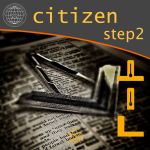 To be a Better Citizen of the World; Step 2 A value proposition for Pure Ancient Masonry as defined in terms of Citizenship; the allegories, symbolism and lessons are a blueprint for all Freemasons to be a better citizen of the world. |
 There are many brotherhoods in the world, and Freemasonry is one of the most significant and successful of them all. This article will be the focus two questions: the importance of brotherhood ? and is there room for improvement in Freemasonry? |
 Intergenerational relations in Masonry: challenges and possibilities Backed with scientific research, Professor Luiz Neto and Professor Alexandre Braune investigate the Intergenerational relations in Freemasonry and explores the challenges and opportunities. |
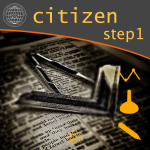 To be a Better Citizen of the World; Step 1 A value proposition for Pure Ancient Masonry as defined in terms of Citizenship; the allegories, symbolism and lessons are a blueprint for all Freemasons to be a better citizen of the world. |
 The Masonic Temple is a platform where both Freemasons and non-Masons, enthusiasts of real art and spiritual growth, connect to the new world of the metaverse. A Freemasonry in the metaverse project, based regular freemasonry principles. |
 Opportunity to fix the Sussex fudge Is there a value proposition for members, that under English Constitution Freemasonry, we have a 4 part offering; Entered Apprentice, Fellowcraft , Master Mason and Companion, conducted in a single craft lodge ? |
 Value Proposition of Freemasonry In addressing declining lodge membership and lack of attendance, we need to assess the value it offers to members. What is value, and what does it mean to you? |
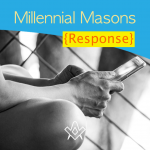 What is a 'Millennial' and what do they want from Freemasonry? You'll be surprised at the answers. |
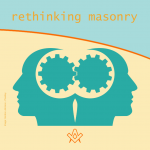 Let us help answer a fundamental question, from a confused newly raised brother asking “What does it all mean and where do I go from here?” |
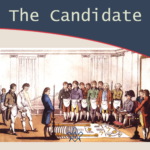 Written in 1930, much of the advice is still relevant today - although some may provoke further thought or debate! |
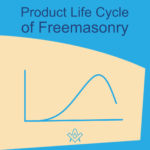 Product Life Cycle of Freemasonry An inconvenient truth about the product life cycle of Freemasonry |
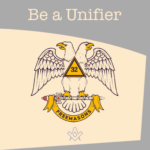 Freemasonry is local. This is where we need to start. We start with our Facebook friends, our neighbours, our colleagues, our lodges… |
 Freemasonry in the time of pandemic The Rule of Six. Localised lockdowns. Second wave? What do we do now?! The answer is simple - engage with members, promote Masonic education and get thinking outside the lodge. |
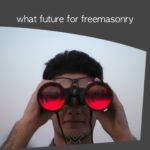 The current functioning of the Masonic movement has some positive aspects and others that are blatantly backward and counterproductive. |
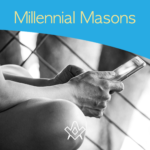 What is a 'Millennial' and what do they want from Freemasonry? You'll be surprised at the answers. |
 How to improve your Lodge Membership Marketing Program. |
 The Anti-Social Impact of Social Media The 'dark side' of social media and its negative effect on our mental health |
 If Freemasonry cannot meet, is this an opportunity to make a change to how we do things? |
 Has your lodge accepted an unknown candidate from the internet? Third in a three-part series looking at the process to accepting candidates via the internet |
 Is the brother of a brother a brother ? Rights to visit - recognition and regularity re-evaluated. |
 The second article in the Unknown Candidate series - Outlining the social media marketing process to attract the unknown candidate to make that first enquiry |
 Ask a random Freemason the purpose of Freemasonry and the likely response will be to “make good men, better”. Research undertaken by James Justin Davis Pennsylvania Academy of Masonic Knowledge. |
 Has your lodge accepted an unknown candidate from the internet? First in a three-part series looking at the process to accepting candidates via the internet |
 Mental Health - Raising its awareness and how we as Freemasons throughout the entire UK can help our fellow brethren and their families when they need it. |
 Share one thought why freemasonry is relevant today - Open question posted on Facebook with a very wide range of responses from Brethren across the globe |
 The Tipping Point of Freemasonry Why do brothers lose interest in Freemasonry and what can we do to get that spark back? At what moment did our own thoughts begin to waver? |
masonic knowledge
to be a better citizen of the world
share the square with two brothers

click image to open email app on mobile device
